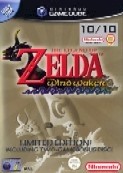News: Zelda transcript
Posted 05 Jul 2002 at 20:48 by guest
In an interview held by Nintendo Power Magazine, Miyatomo and Iwata revealed a few juicy details on The Legend Of Zelda on GameCube.
Miyatomo -- Nintendo Power interview - 07/03/02
NP: Even certain games that are based on existing cartoons have only partially recreated the cartoon experience. What do you think are the real challenges of making a game like The Legend of Zelda play like a cartoon?
Miyamoto: I think a really large goal was to find a kind of expression that really fit the Zelda world--to create his own universe. In doing so, we came up with many ideas and went with the cartoon-style of cel-shading that we now have. But from early on, the designers were able to look at the style of cel-shading and understand what elements of that really fit the Zelda world and helped to draw out the characters in the world. From all over E3, we can see that cel-shading is a kind of trend in game technology, and there are many games that are trying it. But in Zelda, we're not just taking this technological trend and applying it to he game. We're really taking the idea of it being a cartoon and creating the entire world as a cartoon rather than just applying a graphic technique to an already created world. So we're using cartoon-style expression on Link's face and cartoon-style in the emotions and animations of other characters as well. The whole world feels like a cartoon, rather than just using this cartoon technology and applying it to a medium.
NP: Where does the latest Zelda game fall into the series' mythology? Early in the series or after Majora's Mask?
Miyamoto: This is the very first Zelda story. If all we ever did was try to continue the story, we'd lose some of the interest. It's fun to jump back and forth.
NP: On the E3 demo of The Legend of Zelda for the Nintendo GameCube, the boss fight with the lava monster is as thrilling as the big finales from the very best feature-length cartoons. What has the power of the GCN enabled you to do with the Zelda-style boss fights?
Miyamoto: To put it simply, in games you have a lot of elements. Graphic effects, flame, smoke, particle effects- things like that. And you have the processing and computation needed to create a monster's animations and movements. You also have the sound, using Dolby Pro Logic II Surround Sound, which plays an important role. Taking all of those into consideration, the Nintendo GameCube is an extremely well-balanced piece of hardware. The overall ability to handle these different effects is very good and makes the complete effect very strong. On top of that, we have our own basic ability to come up with easy-to-control camera systems and menu interfaces and items and designs that are really suited to the world. So I think it's a culmination of a lot of elements that have allowed us to do this with the Nintendo GameCube.
NP: In that case, can you just tell us about other visual effects in the game? The heat waves are totally impressive. What else will we see?
Miyamoto: There are lots of other effects like the lighting effects, water effects and whatnot. Such effects like the heat waves are one of the Nintendo GameCube's strong points. It's really good at those, and you can see similar types of effects with Metroid Prime. When you use the charge beam, it has great warp effects.
Iwata: They're called indirect textures.
Miyamoto: There will be a lot of scenes where there's lots of fog and you'll see impressive particle and lighting effects.
Iwata: There are also some really cool forest scenes in the game-really beautiful scenes.
NP: So with games like The Legend of Zelda, the next game in the franchise, how do you personally measure the size of a game-compared to what you accomplished with the previous game?
Miyamoto: When designers first start thinking about a game-and they're comparing it to games they remember-they generally tend to plan that games are huge. However, they often remember the games they played and had a great time with as being bigger than they actually were. When you ask how I personally define how big a game is, my emphasis is on play time, which can be hard to gauge. We try to create games for people to play multiple times. That was the idea behind Pikmin. You can play that game the first time through and perhaps it may take you 10-15 hours, whereas another player may take just five hours. I saw that as a game that you can play all the way through at least three times. The same goes for The Legend of Zelda: Majora's Mask. In that game, the flow of time was directly involved-you could speed up or slow down time. The idea was to let people play through at different speeds, so that they might take a different path each time they played the game.
Interview courtesy of Nintendo Power Magazine.























